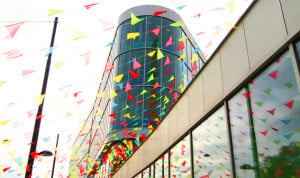Damien Hirst says that all art is focused on death. Not so, says Amy Smith, who delves into recent art history to reveal key pieces that sing out with joy
Félix González-Torres, Untitled
In some circumstances a big pile of free sweets would provide the perfect opportunity for a giant leap, mouth wide open, into a mound of hard-boiled goodness. But put that pyramid of sugar into an art gallery and it’s a different situation.
Félix González-Torres (1957-1996) created 19 separate works involving sweets that are freely available for the public to take. However, many visitors are suspicious, unsure of the etiquette. Others are delighted to rebel and ‘steal’ part of an artwork.
Like all contemporary art, each piece comes laden with different meanings and counter readings. González-Torres said the dwindling mass of the sweets represented the shrinking weight of his dying lover, Ross Laycock (okay, so maybe art is sometimes about death). But he also specified a set weight for each piece to ensure that the sweets are replenished and the mass restored.
What could be a mawkish sentiment suddenly becomes a romantic gesture. There is an element of destruction – the audience collaborates to literally eat away the work, but in an optimistic twist, what has been taken is replaced.
González-Torres’ work continues to be shown internationally. For details on current exhibitions visit: www.felixgonzalez-torresfoundation.org
Chu Yun, Unspeakable Happiness
Bunting has recently made quite a comeback; it’s almost impossible to attend a street party without felt, flowery, pirate-themed, multicoloured or recycled pendants stretching across a road and declaring it’s party time. However, only a few years ago bunting was synonymous with secondhand car dealerships.
Chinese artist Chu Yun explores the happy symbolism of bunting in his conceptual piece, Unspeakable Happiness. Here, Chu enters into a contract with the gallery that bunting will be displayed in the space for an agreed period of time, after which point it will be destroyed. The work is only completed once a document of its destruction has been sent to Chu.
Unspeakable Happiness focuses heavily on how it’s received by the audience. Does the colourful stream of flags promise a good time? Chu Yun has always been interested in our unconscious reactions to everyday symbols. “I think we are more liable to being unconsciously changed by things we cannot easily observe,” he says. “And that these things change us even more quickly and drastically.”
More information: Vitamin Creative Space
Jeremy Deller and Alan Kane, Folk Archive
Those interested in Britain’s culture need to make a date with Jeremy Deller and Alan Kane’s Folk Archive. The collection lovingly celebrates some of this country’s funniest, weirdest and wackiest traditions, making for an incredibly heartwarming honouring of the creative practices that take place outside of galleries.
Turner Prize-winning artist Deller and pal Kane spent seven years trawling these isles, visiting women’s institutes, protest groups, dance troupes, small village communities, prisoners and lone enthusiasts.
It turns out we’ve been doing some downright quirky things in this country for a while, including rolling lit barrels down hills, dancing ribbons around poles, tossing cabers, gurning for prizes, dressing up as old ladies for nights out in Blackpool, knitting emergency service-themed pin cushions, wheelbarrow racing, and sculpting furniture from hedges.
The archive is astoundingly broad. A personal favourite is a collection from Cornish jobcentre worker Dean Briggs, who creates a new illustration for each of the sick notes he handles.
The 250-strong archive can be viewed here: www.britishcouncil.org/folkarchive/folk.html

